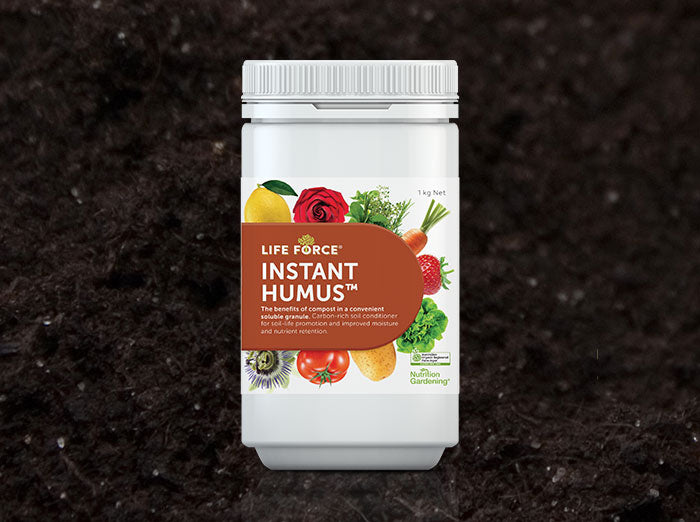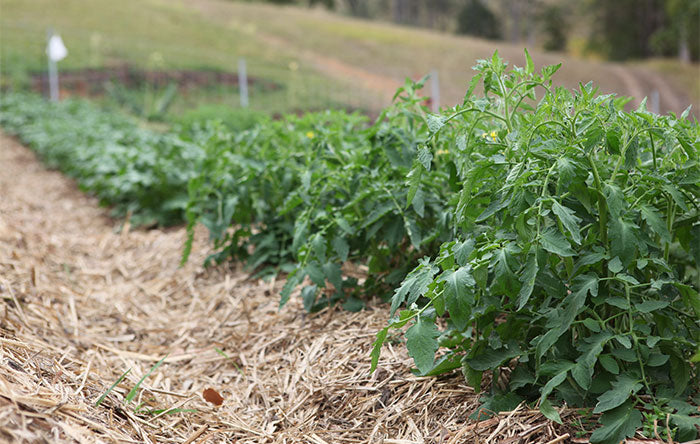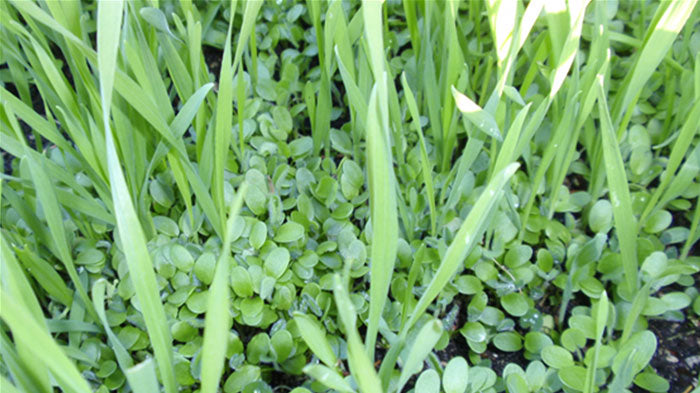Ten Tips for a Problem-Free, Super Productive Home Garden (Part 4)

In this fourth segment of this series, we will discuss the sustenance and support of your soil life and the importance of always avoiding naked soil.
8) Supporting the Workforce
If you can begin to see the trillions of microbial creatures in your garden as your hidden workforce, then you are on the path to happy gardening. When we recognise that we are dealing with a workforce, then we understand that if we mistreat our workers, there will be increasing problems. Conversely, if we can look after them, they will look after us. Nutrition Gardening® is essentially a workplace health and safety issue. Health is about providing food and ideal living conditions for your workforce, while safety is about protecting them from toxins and poor soil management decisions.
The foods to help your soil microbes survive and thrive are now readily available for home gardeners. The bacterial component of your soil loves simple carbohydrates. Molasses is a good option, but even table sugar is of benefit because we are chasing the energy factor more than the extra minerals found in molasses. The ideal dose rates for both involve two tablespoons of either sugar or molasses, in a watering can full of water, applied to 10 m2 of soil.

However, there is a natural acid that is more potent than simple sugars. Fulvic acid can be extracted from certain forms of brown coal, and it is regarded as the most powerful known bacterial stimulant. Your bacterial workforce is well worthy of support. These tiny creatures (500,000 on a pinhead) fix nitrogen from the atmosphere, solubilise and deliver mineral nutrition, support plant immunity and protect from disease.
The second natural acid, extracted from ancient organic matter, is humic acid, which we have discussed previously. This material involves more complex carbohydrates and it is the preferred food of beneficial fungi in your soil. Fungi are often missing in action in our soils through the use of fungicides, herbicides, acid/salt fertilisers and over-tillage. Fungi create stable humus from crop residues. This stabilised carbon remains in our soils, and therefore out of our atmosphere (as CO2), for over 35 years. Fungi also protect plants from disease, deliver nutrition and support immunity.
The most important benefit of fungi, however, is their capacity to create crumb structure in your soil. This is the most desirable characteristic for garden soils. A soil with crumb structure can breathe freely while allowing ease of root growth and ideal water infiltration. Earthworms move unimpeded through these aggregates, as do beneficial nematodes and microarthropods. You can plunge your hands deep into this medium and it smells good enough to eat. Gardening is pure pleasure when you have achieved this holy grail of good soil management, but it is not possible without nurturing your fungal workforce. Life Force® Instant Humus™ involves super-concentrated soluble humic acid granules. Two teaspoons of these black crystals are added to a watering can full of water, and applied to 10 m2 of soil. You will almost hear your fungi rejoice!

Kelp as a Microbe, Plant and Human Food
Kelp is another Nutrition Gardening® essential. It is also a fine fungal food, as it is replete with the long chain sugars favoured by these creatures. Kelp also contains the full spectrum of minerals from the ocean, to offer complete nutrition to microbes and plants alike. This gift from the ocean offers many other plant support benefits. It is the highest known natural source of iodine, for example. This protective mineral is missing in most soils and consequently, in most diets. Thyroid malfunction, reproductive problems and susceptibility to heavy metal contamination are just some of several consequences of our widespread iodine deficiency. There are multiple benefits associated with providing kelp to the soil and to the tissues of plants, animals and humans.
Kelp contains substantial levels of a powerful chelating agent called mannitol. This ensures that the rich mineral lode found in seaweed is made more plant-available. Additional minerals you might choose to include with kelp will also be naturally chelated and, hence, are more effective.

Finally, kelp contains very high levels of four plant growth promoters that are required for every stage of healthy, resilient progress during the crop cycle. Cytokinins, gibberellins, auxins and betaines are produced by the plant, from mineral building blocks in the soil. Beneficial microbes also build these hormones from minerals and feed them to the plant in a “give and you will receive” relationship.
Extractive agriculture has seen the long-term, persistent removal of these broad spectrum trace minerals with no replacement. In fact, it could be argued that most plants no longer have the associated hormonal support to achieve their genetic potential. The exception is the seaweed plant, which exists in a soup comprising the perfect balance of all minerals. Consequently, this plant contains forty times more of these hormonal helpers than land plants. What does this mean for this sea plant? Well, it is the fastest-growing plant on the planet, producing 30 cm of new growth every day. We can boost our hormone-deficient, garden plants with seaweed fertiliser. In this context, kelp becomes an essential supplement for a healthy, vigorous, food-producing garden.
You might be thinking at this point that seaweed might also be a good inclusion in your diet, and you are right. Minerals are the precursors for everything that makes our food our medicine. All of the phytonutrients, including vitamins, come from minerals, and this sea plant is bathed in the perfect balance of these building blocks. One of the best ways for us to access this medicine is to source dried kelp (wakame) from a health store or Asian grocer. The creation of delicious seaweed salads is as simple as adding water and a tasty dressing.

9) Naked Soil is Never Good
Your body builds vitamin D3 from 17 minutes of full sun exposure each day and the more unclothed the better. However, soils do not appreciate naked exposure at any time. That is the reason Nature fills the void whenever soil is uncovered. Plants provide a living, protective cloak over precious topsoil, to shelter, insulate and sustain that vibrant medium. Plants feed beneficial soil life with a constant flow of glucose, some of which is converted to humus (to offer more long term support to both microbes and crops). There is a constant, dynamic flow of communication between plants and plants, plants and microbes and between all forms of soil life. This ceaseless chatter is all about maximising the health and vitality of this inextricably interrelated universe beneath our feet. When you remove the plants from this community, the system crashes very quickly. That is one big reason why you never leave soils bare.
While a living cover is preferable, at least a mulch provides food and protection to the soil and its inhabitants. Nutrition gardeners gradually embrace this nurturing instinct, as they develop a genuine reverence for their soil. They become soil lovers.

Learning to Love Cover
Cover cropping has become something of a global phenomenon, as farmers discover the benefits of this sustainable strategy. However, home food producers need to know why they would also benefit. The concept obviously involves avoiding a naked soil, for the reasons already considered, but there are many other benefits.
7 Reasons To Run For Cover
-
To provide biodiversity – we are learning to work with Nature, and biodiversity is the dominating principle throughout this realm. The simple fact is that plants do better in the presence of other plants. People tend to congregate in cities, and the more ethnic diversity present, the greater the fun, food and culture. Imagine how boring Australian cuisine would be in the absence of Asian, African and European influence. We might just as well stay at home munching our meat pies and two veg, to the music of Tex Morton and Slim Dusty. The point is that diversity is critical for microbes, plants and humans. “The more the merrier” is a driving dynamic when considering species diversity. Ignoring this natural law is a fatal flaw in the monoculture model of modern farming. In one study involving cover crop trials in multiple US states, it was found that, in every case, the plots with the greatest diversity delivered the best outcomes.
-
To help manage weeds – if you have raised beds in your garden (and you probably should for optimal drainage), then the inter-row could host a cocktail cover crop rather than providing a haven for weeds. You are effectively “choosing your weeds” in this instance, by replacing unwanted invaders with functional plants offering multiple benefits.
-
To feed soil life – your cover crop means you are achieving more photosynthesis per square metre. 50% of the glucose produced from the sugar factories in the leaves is pumped down to feed the roots. 60% of that carbon is then exuded into the soil to feed the army of organisms surrounding the root. Some of that sweet feedstock is converted to stable humus. In this manner, your cover crop is a means of carbon sequestration, to help reverse global heating. It is also important to realise that different plants feed different microbes, so the greater the biodiversity above ground, the greater the biodiversity below.
-
To build humus – the carbon sequestration opportunity involves more than glucose exudates to the root zone. When the cover crop is turned in, or slashed with a line trimmer, it can decompose and further increase organic matter. The oxygen pathways introduced by deep-rooted cover crops, like daikon radish, can further stimulate humus-building organisms.
-
To prevent erosion – in the US, 3 – 5 tonnes of topsoil per year is lost through erosion. There are just 60 years until zero topsoil remains on our planet, unless we change the way we grow food. We cannot survive without topsoil! This problem is worsening with the dramatic increase in extreme weather events associated with climate change. A naked soil is an invitation for erosion, as there is no plant root-stabilising effect, and no building of the ‘glue’ (humus and microbial exudates) that holds everything together.
-
To manage pests and nurture bees – plants like mustard and marigolds are very effective in countering the most destructive of all crop pests, root knot nematodes. Brassicas emit biochemicals from their roots, which can reduce root disease in other food crops. However, it is important to rotate brassica plantings in your garden with other species to avoid a buildup of these chemicals. Cover crops can also serve as trap crops for pests to keep them away from your vegetables. Alternatively, they can also be host plants for beneficial predators. Flowering cover crops can also attract and feed pollinators. This will boost production in your garden while feeding the all-important honey bee. These creatures are really struggling around the globe at present. A condition called Colony Collapse Disorder is decimating beehives, to the point that beekeeping is no longer a viable profession in some regions. Insecticides called neonicotinoids, GMO crops and electromagnetic radiation from phone towers seem to have combined to mess up the immunity and communication skills of these critically important creatures. Einstein suggested that the world lasts just four years in the absence of the honey bee and their pollination gift. Your garden can serve as a chemical-free haven, to help preserve our bees.
-
To supply nitrogen – I have fond memories of my Dad planting his blue lupin cover crop in our vegetable garden. I was paid ten cents an hour to chop up and turn in this dense, metre-high mass. A few weeks later the soil was churning with happy earthworms and our nitrogen-rich soil was ready to plant. Legumes, like lupins, clovers and lucerne, fix nitrogen from the atmosphere and deliver this desirable ammonium form of nitrogen into the root zone. The ideal ratio between ammonium and nitrate nitrogen is 3:1 (in favour of ammonium nitrogen) and this ratio is a big player in pest resistance. You may struggle to achieve this resilience ratio in your garden without some legumes present in the planting mix.

Cocktail Cover Crops – a Soil-Building Breakthrough
Brazilian agronomist Aldemir Caligari is responsible for a revolutionary cover cropping finding with wonderful outcomes in agriculture. However, this super-productive strategy, called cocktail cover cropping, is equally valid for home gardeners seeking to fast-track improvements in soil structure and humus generation.
Caligari shared a momentous finding. He has demonstrated that, when five specific plant families are included in a cover crop blend, something amazing happens. The plant roots begin messaging each other and then initiate an outpouring of phenolic compounds into the soil. Phenolic compounds are the reason that we drink green tea. These powerful antioxidants affect us at a cellular level, and it turns out they have a similar impact upon the trillions of tiny creatures beneath our feet. The soil-life moves into hyperdrive in the presence of these root exudates and all of the good things that microbes bring happen much more rapidly. There are some growers claiming that they are seeing a four-fold increase in positive changes when adopting this cocktail cover cropping strategy.
The hyperdrive effect only happens when all five species are involved. The five families involved include grasses, cereals, legumes, brassicas and chenopods. There are some cover crop blends that include the first four, but they usually exclude the essential chenopod component. Chenopods comprise a small group of plants that include the beet family, spinach, amaranth and quinoa. They are only required at 1% of the total blend but if they are missing, then so is the big kick. Brassicas should also be seen as something of a seasoning spice in the recipe. They should not comprise more than 6% of the total mix.

Once again, it is always better to have as many different plants in the blend as feasible, in recognition of the “more the merrier” principle. A good home garden cover crop blend might include ryegrass, barley, wheat, lucerne, three clovers, daikon radish, kale and silverbeet. You will note that all species are edible here and you could easily snip as required for a chlorophyll-packed addition to your green smoothie. You could even juice the young wheatgrass and barley grass at the height of their antioxidant powers.
Next week, in the final segment of this series, we will look at the need to rotate your food crops. We will also consider the emerging science of companion planting, and a phenomenon called allelopathy.
To go back to Part 1 of this article, please click here.
Sign up to our e-newsletter to receive the latest articles, product updates and exclusive offers from NTS. Every new subscription receives a free digital copy of Graeme Sait's book, 'Nutrition Rules!'. CLICK HERE TO SUBSCRIBE
